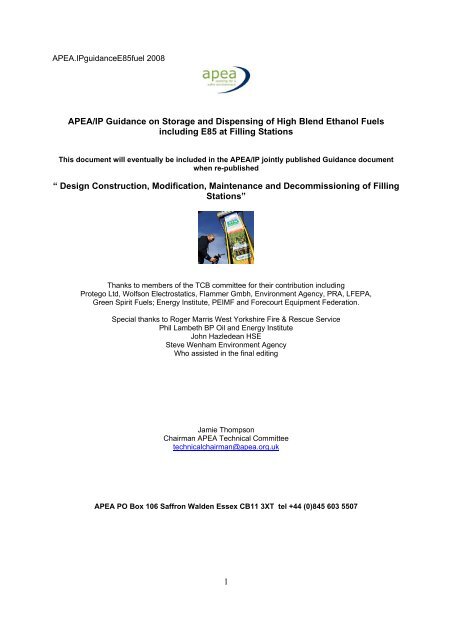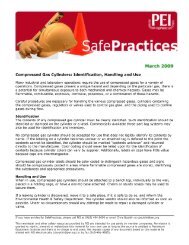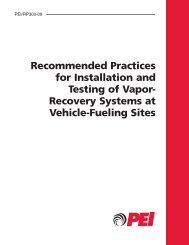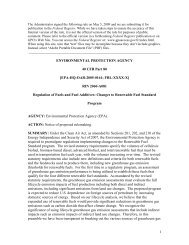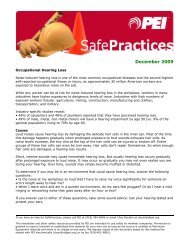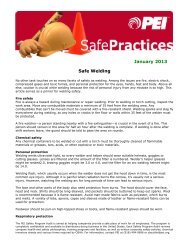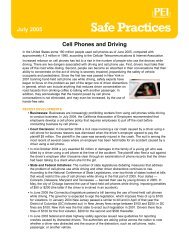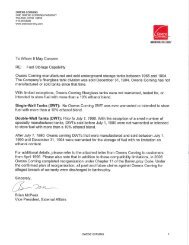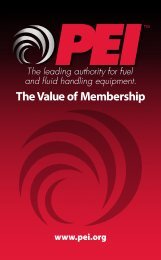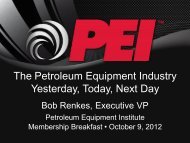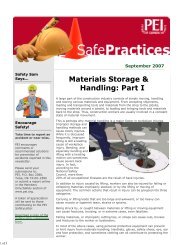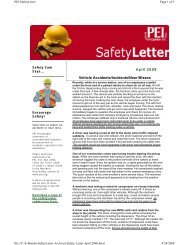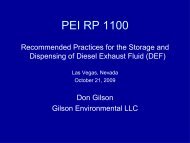1 APEA/IP Guidance on Storage and Dispensing of High Blend ...
1 APEA/IP Guidance on Storage and Dispensing of High Blend ...
1 APEA/IP Guidance on Storage and Dispensing of High Blend ...
You also want an ePaper? Increase the reach of your titles
YUMPU automatically turns print PDFs into web optimized ePapers that Google loves.
<str<strong>on</strong>g>APEA</str<strong>on</strong>g>.<str<strong>on</strong>g>IP</str<strong>on</strong>g>guidanceE85fuel 2008<str<strong>on</strong>g>APEA</str<strong>on</strong>g>/<str<strong>on</strong>g>IP</str<strong>on</strong>g> <str<strong>on</strong>g>Guidance</str<strong>on</strong>g> <strong>on</strong> <strong>Storage</strong> <strong>and</strong> <strong>Dispensing</strong> <strong>of</strong> <strong>High</strong> <strong>Blend</strong> Ethanol Fuelsincluding E85 at Filling Stati<strong>on</strong>sThis document will eventually be included in the <str<strong>on</strong>g>APEA</str<strong>on</strong>g>/<str<strong>on</strong>g>IP</str<strong>on</strong>g> jointly published <str<strong>on</strong>g>Guidance</str<strong>on</strong>g> documentwhen re-published“ Design C<strong>on</strong>structi<strong>on</strong>, Modificati<strong>on</strong>, Maintenance <strong>and</strong> Decommissi<strong>on</strong>ing <strong>of</strong> FillingStati<strong>on</strong>s”Thanks to members <strong>of</strong> the TCB committee for their c<strong>on</strong>tributi<strong>on</strong> includingProtego Ltd, Wolfs<strong>on</strong> Electrostatics, Flammer Gmbh, Envir<strong>on</strong>ment Agency, PRA, LFEPA,Green Spirit Fuels; Energy Institute, PEIMF <strong>and</strong> Forecourt Equipment Federati<strong>on</strong>.Special thanks to Roger Marris West Yorkshire Fire & Rescue ServicePhil Lambeth BP Oil <strong>and</strong> Energy InstituteJohn Hazledean HSESteve Wenham Envir<strong>on</strong>ment AgencyWho assisted in the final editingJamie Thomps<strong>on</strong>Chairman <str<strong>on</strong>g>APEA</str<strong>on</strong>g> Technical Committeetechnicalchairman@apea.org.uk<str<strong>on</strong>g>APEA</str<strong>on</strong>g> PO Box 106 Saffr<strong>on</strong> Walden Essex CB11 3XT tel +44 (0)845 603 55071
<str<strong>on</strong>g>APEA</str<strong>on</strong>g>.<str<strong>on</strong>g>IP</str<strong>on</strong>g>guidanceE85fuel 2008OVERVIEW1 <strong>Storage</strong> <strong>and</strong> <strong>Dispensing</strong>:1.1 Existing general c<strong>on</strong>trol measures for the storage <strong>and</strong> dispensing <strong>of</strong> petroleum-spirit can,with certain excepti<strong>on</strong>s, be equally applied to alcohol fuels such as HBEF. The guidance given inthe Blue Book 1 , as supplemented by this Note, should be followed for new installati<strong>on</strong>s, redevelopments<strong>and</strong> modificati<strong>on</strong>s.1.2 The physical characteristics <strong>of</strong> HBEF relative to petrol require special c<strong>on</strong>trol measuresto minimise the risk <strong>of</strong> fire or explosi<strong>on</strong> <strong>and</strong> envir<strong>on</strong>mental c<strong>on</strong>taminati<strong>on</strong> where the fuel is stored<strong>and</strong> dispensed. The characteristics giving rise to the need for additi<strong>on</strong>al c<strong>on</strong>trol measures canbe broadly categorised as: -- Material compatibility- Increased c<strong>on</strong>ductivity- A wider flammability range; <strong>and</strong>- Solubility with water2 Material Compatibility:2.1 HBEF have different properties to those <strong>of</strong> petrol, which means special c<strong>on</strong>siderati<strong>on</strong>shave to be made when choosing equipment <strong>and</strong> materials for certain comp<strong>on</strong>ents <strong>of</strong> theinstallati<strong>on</strong>. Some c<strong>on</strong>venti<strong>on</strong>al materials (such as aluminium, zinc <strong>and</strong> brass) used in petrolstati<strong>on</strong>s together with some plastic <strong>and</strong> rubber materials may be adversely affected by HBEF.2.2 The presence <strong>of</strong> materials in the installati<strong>on</strong> that are incompatible with HBEF can be thecause <strong>of</strong>: -- Leaks due to degradati<strong>on</strong> that can give rise to fire/explosi<strong>on</strong>, safety <strong>and</strong> envir<strong>on</strong>mentalc<strong>on</strong>cerns.- Fuel quality problems caused by suspended matter (c<strong>on</strong>taminati<strong>on</strong>) in the fuel resulting fromthe effects <strong>of</strong> corrosi<strong>on</strong> <strong>and</strong> degradati<strong>on</strong> <strong>of</strong> unsuitable comp<strong>on</strong>ents <strong>and</strong> fittings.3 Increased C<strong>on</strong>ductivity3.1 Ethanol has approximately ⅓ <strong>of</strong> the c<strong>on</strong>ductivity <strong>of</strong> water <strong>and</strong> is at least 10 times morec<strong>on</strong>ductive than petrol. Whilst these characteristics reduce the risk <strong>of</strong> static accumulati<strong>on</strong> thepossibility <strong>of</strong> galvanic corrosi<strong>on</strong> is increased <strong>and</strong> should be taken into c<strong>on</strong>siderati<strong>on</strong>.3.2 Particular attenti<strong>on</strong> must, therefore, be given to the specificati<strong>on</strong> <strong>and</strong> approvals <strong>of</strong> allequipment in c<strong>on</strong>tact with the fuel, (such as submersible pumps, tank gauge probes <strong>and</strong> overfillpreventi<strong>on</strong> devices or probes) as the increased c<strong>on</strong>ductivity may also give rise to the formati<strong>on</strong><strong>of</strong> local corrosi<strong>on</strong> cells between adjacent dissimilar metals.4
<str<strong>on</strong>g>APEA</str<strong>on</strong>g>.<str<strong>on</strong>g>IP</str<strong>on</strong>g>guidanceE85fuel 2008- Fill, vent <strong>and</strong> sucti<strong>on</strong> pipes- Pressure <strong>and</strong> vacuum valves- Flame arrestors- Delivery calming devices- Overfill preventi<strong>on</strong> devices- Dipsticks- C<strong>on</strong>tents gauges- <strong>High</strong> level alarms- Submersible pumps- Gaskets <strong>and</strong> sealants- Water detecti<strong>on</strong> systemsC<strong>on</strong>tents Gauges6.5 Capacitance probes are not suitable as gauges in any level <strong>of</strong> HBEF as they will not workin alcohol6.6 Operators with magnetostrictive probes (or other technology) should c<strong>on</strong>firm withmanufacturers that c<strong>on</strong>structi<strong>on</strong> <strong>and</strong> operati<strong>on</strong> <strong>of</strong> floats are compatible with HBEF.Pipework:6.7 The underground pipework that will carry or come into c<strong>on</strong>tact with HBEF <strong>and</strong> its vapours(ie sucti<strong>on</strong>/pressure, <strong>of</strong>f-set fill, siph<strong>on</strong> <strong>and</strong> vent pipes) should be c<strong>on</strong>structed in accordance withEN 14125 11 , with third party certificati<strong>on</strong> <strong>of</strong> material compatibility.6.8 Existing underground screwed galvanized steel pipe work should not be used as anycorrosi<strong>on</strong> at internal cut pipe ends will be accelerated <strong>and</strong> it will also be difficult to c<strong>on</strong>firm thatthe jointing compounds are HBEF compatible.Dispensers, Hoses & Nozzles6.9 Existing dispensing equipment <strong>and</strong> attached comp<strong>on</strong>ents are unlikely to be compatiblewith HBEF. Advice should be sought from the manufacturer(s) to ensure that all the comp<strong>on</strong>entparts <strong>of</strong> the dispenser are compatible or that those which require adaptati<strong>on</strong> or replacement areidentified.In-Line Filters:6.10 HBEF will initially act as a scouring/cleaning agent removing any debris or sludge in anexisting fuel system. A regime <strong>of</strong> filter maintenance should be put in place to avoid filterblockage, slow flow, damage to meters <strong>and</strong> nozzle. The fitting <strong>of</strong> additi<strong>on</strong>al in line filters may bec<strong>on</strong>sidered in the initial period.11 BS EN 14125:2004: Thermoplastic <strong>and</strong> flexible metal pipework for underground installati<strong>on</strong> at petrol filling stati<strong>on</strong>s.7
<str<strong>on</strong>g>APEA</str<strong>on</strong>g>.<str<strong>on</strong>g>IP</str<strong>on</strong>g>guidanceE85fuel 20089 Electrical Certificati<strong>on</strong> for Hazardous Areas:9.1 Unleaded petrol <strong>and</strong> HBEF <strong>of</strong> up to 90% are c<strong>on</strong>firmed as gas group IIA; whereas HBEF<strong>of</strong> 90%+ has been determined to be gas group IIB. If it is intended to store <strong>and</strong> dispense HBEF<strong>of</strong> 90%+, it is important that the existing (or any new/replacement electrical equipment) installed(or used in the case <strong>of</strong> portable equipment) in the hazardous areas are checked for correctcertificati<strong>on</strong> due to the different gas group.10 Static Electricity:10.1 With regard to igniti<strong>on</strong> by static electricity the risk is less but the fuel should be treated asunleaded fuel for this purpose.11 Fire fighting equipment:11.1 Dry powder extinguishers or alcohol resistant foam extinguishers should be providedwhere HBEF are stored <strong>and</strong> dispensed.10
<str<strong>on</strong>g>APEA</str<strong>on</strong>g>.<str<strong>on</strong>g>IP</str<strong>on</strong>g>guidanceE85fuel 200812 Signage:12.1 At the time <strong>of</strong> writing this guidance, there are no EU or UK recognised identificati<strong>on</strong> signsfor storage tank fill points <strong>and</strong> fuel dispensers. In the absence <strong>of</strong> an EU st<strong>and</strong>ard, it isrecommended that the design <strong>and</strong> wording <strong>of</strong> the two signs as displayed below be used in theUK.<strong>Storage</strong> tank fill pointHB ETHANOLE85E85HB ETHANOL 85Background – Pink – RAL4003Text / block outline: BlackNote:In order to reduce the risk <strong>of</strong> customers inadvertently dispensing HBEF, site operators shouldensure that the nozzle <strong>and</strong> dispenser are c<strong>on</strong>spicuously labelled13 C<strong>on</strong>verting <strong>and</strong> commissi<strong>on</strong>ing existing sites <strong>and</strong> <strong>on</strong>going maintenance13.1 It is essential that a full survey <strong>of</strong> the existing site be carried out to identify anycomp<strong>on</strong>ents that may be incompatible with HBEF. Where there is doubt reference to the OEM’sequipment manual for suitability <strong>of</strong> existing equipment, <strong>and</strong>/or the replacing <strong>of</strong> unsuitableequipment as is necessary. A competent pers<strong>on</strong> should undertake the scrupulous cleaning <strong>of</strong>the tank(s) <strong>and</strong> product pipe work13.2 A review <strong>of</strong> the site’s (DSEAR) fire <strong>and</strong> explosi<strong>on</strong> <strong>and</strong> COSHH risk assessment shouldbe undertaken before HBEF are introduced.13.3 Experience has shown that HBEF tend to act as a cleaner for fuel systems <strong>and</strong> as aprecauti<strong>on</strong>; fuel tanks <strong>and</strong> associated pipe work should be checked for sludge <strong>and</strong> wherenecessary cleaned before introducing HBEF to the storage tank.13.4 Care should be taken to eliminate water <strong>and</strong> remedy any causes <strong>of</strong> water entry in tanksthat will be used for HBEF storage. As water will readily mix with the alcohol in the fuel, there willbe no free water for the tank (c<strong>on</strong>tents) gauge to detect; so the water detecting capability <strong>of</strong> thisdevice will be effectively redundant. Wet Stock c<strong>on</strong>trol processes or rec<strong>on</strong>ciled gauge systemsthat will detect <strong>and</strong> alarm <strong>on</strong> indicati<strong>on</strong> <strong>of</strong> an unaccountable product increase can provide a11
<str<strong>on</strong>g>APEA</str<strong>on</strong>g>.<str<strong>on</strong>g>IP</str<strong>on</strong>g>guidanceE85fuel 2008c<strong>on</strong>trol measure. In additi<strong>on</strong> to the leak detecti<strong>on</strong> measures, a regular check should be made <strong>of</strong>the seals <strong>and</strong> gaskets <strong>of</strong> tank lids <strong>and</strong> their fittings i.e., fill caps, probes <strong>and</strong> other equipment toensure c<strong>on</strong>tinued integrity.Note:If water-detecting paste is used it should be formulated for ethanol/alcohol fuels.13.5 When c<strong>on</strong>verting a tank from the storage <strong>of</strong> unleaded petrol to an HBEF blend it shouldbe completely emptied <strong>of</strong> product <strong>and</strong> any water that may have accumulated at the bottomshould be removed so that the tank is liquid free as far as is practicable. The tank should thenbe filled as close to capacity as possible with HBEF, to minimize the effect <strong>of</strong> any small amounts<strong>of</strong> water that may remain following cleaning.13.6 If diesel was stored the tank that will be used for the HBEF, it must in be cleaned asdiesel causes some particulates to settle out <strong>and</strong> form sludge. Introducing alcohol into thesetanks will place this sludge into suspensi<strong>on</strong> <strong>and</strong> can lead to serious problems with filter blocking.<str<strong>on</strong>g>Guidance</str<strong>on</strong>g> <strong>on</strong> the cleaning <strong>of</strong> tanks is provided in clause 8.8.2.2 <strong>of</strong> the Blue Book 1 <strong>and</strong> moredetailed guidance is provided in HSE <str<strong>on</strong>g>Guidance</str<strong>on</strong>g> CS15 13 <strong>and</strong> the Model Code <strong>of</strong> Safe Practice No16 Tank Cleaning Safety Code 14 .14 Vapour Recovery:14.1 HBEF are c<strong>on</strong>sidered to be ‘volatile organic compounds’ <strong>and</strong> are subject to the samerequirements as petrol with regard to unloading <strong>and</strong> dispensing <strong>and</strong> as such the guidanceprovided in the Blue Book 1 <strong>and</strong> PG1/14 15 for stage 1b <strong>and</strong> stage 2 will apply.15 Comments:15.1 Comments <strong>on</strong> any aspect <strong>of</strong> this <str<strong>on</strong>g>Guidance</str<strong>on</strong>g> Note should be addressed to the <str<strong>on</strong>g>APEA</str<strong>on</strong>g>’sTechnical Chairman at: -technicalchairman@apea.org.uk13 Health <strong>and</strong> Safety Executive's <str<strong>on</strong>g>Guidance</str<strong>on</strong>g> Note CS15: The Cleaning & Gas Freeing <strong>of</strong> Tanks C<strong>on</strong>taining FlammableResidues;14 Institute <strong>of</strong> Petroleum’s Model Code <strong>of</strong> Safe Practice No 16 Tank Cleaning Safety Code.15 Process <str<strong>on</strong>g>Guidance</str<strong>on</strong>g> Note 1/14(06) Unloading Petrol into <strong>Storage</strong> at Petrol Filling Stati<strong>on</strong>s.12
<str<strong>on</strong>g>APEA</str<strong>on</strong>g>.<str<strong>on</strong>g>IP</str<strong>on</strong>g>guidanceE85fuel 2008APPENDIX 1Properties <strong>of</strong> HBEF, Gas Groups <strong>and</strong> ReferencesProperties <strong>of</strong> HBEFVapour Density’: Ethanol vapour, like petroleum-spirit vapour, is heavier than air <strong>and</strong> tends toaccumulate in the lowest levels surrounding any release <strong>of</strong> the fuel. Unlike petrol vapour,ethanol fuel vapour disperses rapidly.‘Solubility in Water’: Fuel ethanol will mix with water. Where the c<strong>on</strong>centrati<strong>on</strong> <strong>of</strong> water is high,the ethanol will separate.‘Energy C<strong>on</strong>tent’: For identical volumes, fuel ethanol possesses less energy than petroleumspirit.‘Flame visibility’: A fuel ethanol vapour flame, although not as bright as a petrol vapour flame, iseasily discernable in daylight.‘Specific Gravity’: Pure ethanol <strong>and</strong> ethanol fuel blends are heavier than petroleum-spirit <strong>and</strong>lighter than water.‘Electrical C<strong>on</strong>ductivity’: Fuel ethanol c<strong>on</strong>ducts electricity. Petroleum-spirit, by c<strong>on</strong>trast, is anelectrical insulator.‘Stoichiometric Fuel-to-Air Ratio’: E85 needs more fuel/kg <strong>of</strong> air than petroleum-spirit; thereforecannot be used in a c<strong>on</strong>venti<strong>on</strong>ally fuelled vehicle.‘Toxicity’: Ethanol is less toxic than petrol or methanol. Although carcinogenic compounds arenot present in pure ethanol, the 15% blend <strong>of</strong> petroleum-spirit in fuel ethanol (E85) is c<strong>on</strong>sideredto make the substance potentially carcinogenic.‘Flash Point’: Less than -40 0 C.‘Limits <strong>of</strong> Flammability’: 3.3% (LEL) to 19% (UEL). At a low temperature (0 0 C), HBEF vapour ismore flammable than petrol vapour whilst at normal temperatures it is less flammable due to itshigher auto-igniti<strong>on</strong> temperature. The auto-igniti<strong>on</strong> temperature <strong>of</strong> E85 is 360 0 C compared with270 0 C for petrol.Gas GroupsGases <strong>and</strong> vapours are categorised in terms <strong>of</strong> their igniti<strong>on</strong> energy or the maximumexperimental safe gap; the latter in respect <strong>of</strong> flamepro<strong>of</strong> protecti<strong>on</strong> for electrical equipment.With this system <strong>of</strong> categorisati<strong>on</strong>, highly flammable gases <strong>and</strong> vapours are assigned to <strong>on</strong>e <strong>of</strong>four groups. The table below shows the groups with the typical gases or vapours for eachgroup. Gases or vapours falling into group IIC present a more significant (igniti<strong>on</strong>) hazard thanthose falling into group IIA.13
<str<strong>on</strong>g>APEA</str<strong>on</strong>g>.<str<strong>on</strong>g>IP</str<strong>on</strong>g>guidanceE85fuel 2008Mining IndustryGroup IMethaneSurface <strong>and</strong> Petrochemical IndustryGroup IIIIA IIB IICPropane & Petrol Ethylene HydrogenReferences:1 Design, C<strong>on</strong>structi<strong>on</strong>, Modificati<strong>on</strong>, Maintenance <strong>and</strong> Decommissi<strong>on</strong>ing <strong>of</strong> Filling Stati<strong>on</strong>s (2 ndEditi<strong>on</strong>). Published jointly by the <str<strong>on</strong>g>APEA</str<strong>on</strong>g> <strong>and</strong> the Energy Institute. ISBN 0 85293 419X.2 PETEL Circular No.65/61 ‘Petroleum (C<strong>on</strong>solidati<strong>on</strong>) Act 1928 - Petrol Filling Stati<strong>on</strong>s – ModelC<strong>on</strong>diti<strong>on</strong>s <strong>of</strong> Licence’. http://www.hse.gov.uk/lau/lacs/65-61.htm3 Groundwater protecti<strong>on</strong> code: Petrol stati<strong>on</strong>s <strong>and</strong> other fuel dispensing facilities involvingunderground storage tanks. http://www.defra.gov.uk/envir<strong>on</strong>ment/water/ground/petrol/index.htmUnderground <strong>Storage</strong> Tanks for Liquid Hydrocarb<strong>on</strong>s Code <strong>of</strong> practice for the owners <strong>and</strong>operators <strong>of</strong> underground storage tanks (<strong>and</strong> pipelines)http://www.scotl<strong>and</strong>.gov.uk/about/ERAD/WEU/00015561/<str<strong>on</strong>g>Guidance</str<strong>on</strong>g>.aspx4 pr EN 15376 Automotive Fuels: Ethanol as a blending comp<strong>on</strong>ent. Requirements <strong>and</strong> testmethods. (March 2006).5 SAE Technical Papers Series, 950401, ‘Flammability Tests <strong>of</strong> Alcohol/Gasoline Vapours’6 L<strong>and</strong>erausschuss Fur Arbeitsschutz und Sicherheitstechnik. ISBN 3-936415-49-8.7 BS EN 12784 Flame Arrestors: Performance, test methods <strong>and</strong> limits for use.8 BS EN 228 Automotive fuels - Unleaded petrol - Requirements <strong>and</strong> test methods.9 BS EN 12285-1:2003 Workshop fabricated steel tanks. Horiz<strong>on</strong>tal cylindrical single skin <strong>and</strong>double skin tanks for the underground storage <strong>of</strong> flammable <strong>and</strong> n<strong>on</strong>-flammable water pollutingliquids.10 UL2085: 1997 (with later revisi<strong>on</strong>s) St<strong>and</strong>ard for protected above ground tanks for flammable<strong>and</strong> combustible liquids.11 BS EN 14125:2004: Thermoplastic <strong>and</strong> flexible metal pipework for underground installati<strong>on</strong> atpetrol filling stati<strong>on</strong>s.12 BS 7244:1990 Specificati<strong>on</strong> for flame arresters for general use. (now withdrawn).13 Health <strong>and</strong> Safety Executive's <str<strong>on</strong>g>Guidance</str<strong>on</strong>g> Note CS15: The Cleaning & Gas Freeing <strong>of</strong> TanksC<strong>on</strong>taining Flammable Residues.14 Institute <strong>of</strong> Petroleum’s Model Code <strong>of</strong> Safe Practice No 16 Tank Cleaning Safety Code.15 Process <str<strong>on</strong>g>Guidance</str<strong>on</strong>g> Note 1/14(06) Unloading Petrol into <strong>Storage</strong> at Petrol Filling Stati<strong>on</strong>s.http://www.defra.gov.uk/envir<strong>on</strong>ment/ppc/localauth/pubs/guidance/notes/pgnotes/pdf/pg1-14.pdf14


